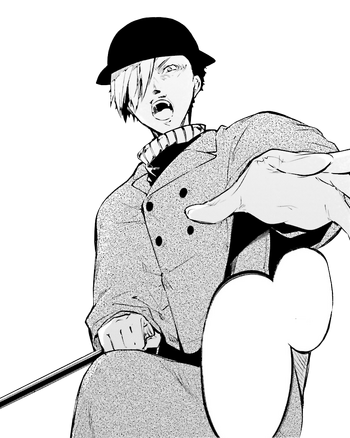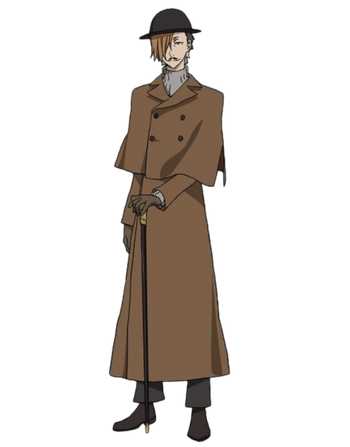Bungo Stray Dogs Wiki
Relationships
Image Gallery
“Writing novels is writing people. It’s about how they live and how they die.“
— Sōseki Natsume to young [1]
— Sōseki Natsume to young Sakunosuke Oda
Sōseki Natsume
-
Manga
-
Anime


Kanji
夏目 漱石
Rōmaji
Natsume Sōseki
Also Known As
Mii-chan (as a cat)
Takutou Sano (fake name)[2]
- For appellations, see Relationships
Namesake
 (Japanese novelist)Sōseki Natsume (Japanese novelist)
(Japanese novelist)Sōseki Natsume (Japanese novelist)
Personal Information
Status
Alive
Gender
![]() Male
Male
Birthday
February 9
Professional Information
Ability
I am a Cat
Reference
Wagahai wa Neko de Aru?)I Am a Cat (吾輩は猫である,,
Occupation
Writer
Appearances
Manga Debut
Chapter 50
Anime Debut
Episode 36
Light Novel Debut
Osamu Dazai and the Dark Era
Portrayal
Japanese Voice
Hōchū Ōtsuka
English Voice
Greg ChunImage Gallery
Sōseki Natsume (夏目 漱石, Natsume Sōseki, Sōseki Natsume?) is a writer and former mentor of Yukichi Fukuzawa and Ōgai Mori. His Ability is named I am a Cat.
Appearance
Natsume is a tall man seemingly in his fifties who always wears a bowler hat, a British-looking, long, brown suit with grey turtleneck shirt underneath, and brown gloves. He is always seen holding a T-shaped cane. He also has a thin mustache and his hair color matches his fur when in cat form: a light chestnut strand of hair hides the right side of his face, the hair above his neck is white and the rest is dark brown. His eyes are of a brownish-golden color.
When in his cat form, Natsume looks like an average-sized calico cat, with patches of orange, dark brown and white fur and brown eyes.

Natsume in his cat form
Personality
Natsume is a highly charismatic man; it is assumed that he influenced Mori and Fukuzawa and is even respected greatly by the two. By merely talking to him about a book, he was even able to convince Sakunosuke Oda, a Port Mafia member, to stop killing.
Ability
- Main article: I am a Cat
Natsume’s ability, I Am A Cat (吾輩は猫である,, Wagahai wa Neko de Aru?) allows him to turn into a calico cat. It is commonly said that Natsume is the strongest ability user, able to see through all kinds of things. Until the end of the Cannibalism events, his ability remains unknown to anyone; only then he reveals the nature of his power to Fukuzawa, Mori, and Katai Tayama by turning back into his human form.
I Am A Cat
吾輩は猫である,
,
Wagahai wa Neko de Aru
?
Manga Debut:
Chapter 50
Anime Debut:
Episode 36
Ability:
Cat Transformation
Background
He is under the government’s witness protection program so he can remain invisible to the public while exchanging information with the witness protection organization.[2] Later on, he made the creation of the Armed Detective Agency possible by helping Fukuzawa obtain the skilled business permit to run an ability-based business.[2] He is the mastermind behind the Tripartite Framework, a framework aiming at preserving the balance and order of Yokohama.[3] He acted as a mentor for both Fukuzawa and Mori about twelve years ago, and the two men met thanks to Natsume’s input. Sometime later, he retired.
History
Natsume appears as a man in a suit, who attended the play “The Living World Is a Dream, the Nocturnal Dream is Reality” at Theatrum Mundi. After the commotion in the theater in which the lead actor, Tokio Murakami was murdered, he disappeared. Later, he was found tied up and unconscious. It was revealed that it was one of Kurahashi’s objectives to meet him, but on a larger scheme, he was targeted for kidnapping. But Natsume was not seen at the theater again when Fukuzawa deduce Ranpo’s hint about the true culprit.[2]
Natsume is named as the author of a three-part novel that Oda used to enjoy reading and gave Oda the inspiration not to kill and be a writer instead.[1]
Plot
Natsume repeatedly appears in his cat form as Kirako Haruno’s pet Mii-chan.
When Francis Scott Key Fitzgerald attempts to buy the permit of the Agency from Fukuzawa, the latter dryly refuses, calling the permit an embodiment of Natsume’s efforts.[4]
When Fukuzawa falls gravely ill because of the Cannibalism virus, Natsume, as Mii-chan, vanishes from Haruno’s home. He is later seen on several occasions, always in his feline form: once by Tanizaki while he was roaming on the streets; then near Dazai’s hospital window, a dried sardine between his teeth; and finally, during the battle between Mori and Fukuzawa.
While the two leaders are fighting each other, Haruno and Naomi Tanizaki wonder about the disappearance of Mii-chan and how the cat always vanishes before disasters are on the brink of happening. It is later revealed that Katai Tayama deceived Fyodor Dostoevsky and faked his own death thanks to Natsume’s help. Natsume in cat form then passes the information about the Rats in the House of the Dead’s hideout’s location to Osamu Dazai through a dried sardine.
Natsume silently watches as Fukuzawa is defeated by Mori and is bleeding out on the floor. The Port Mafia leader is prevented from killing the President by the sudden explosion of the mansion and the transformation of Natsume who reveals his true appearance. Natsume scolds his two former disciples for being so troublesome, tells them about the discovery of the enemy hideout’s location, and urges them to save their lives and prove themselves worthy of the trust he put in them and their respective organizations.[3]
Appearances
Quotes
- (To Ōgai Mori and Yukichi Fukuzawa) “I have great faith in your organizations. You are not so hopless as to have vermin gnaw upon you.“[3][5]
Etymology
- The name Sōseki means “gargle” (漱) (sou) and “stone” (石) (seki).
- The surname Natsume means “summer” (夏) (natsu) and “eye” (目) (me).
Namesake
Sōseki Natsume (January 10, 1835 – February 3, 1901)
- As one of the most well-known and influential Japanese writers, Natsume has a handful of works that have become a centerla part of the modern literature reportoire in Japan such as I Am a CatKokoroSanshirōBotchanI Am a Cat is a novel narrated by a cat who tells the life stories of various middle-class people during the Meiji[6]
References
